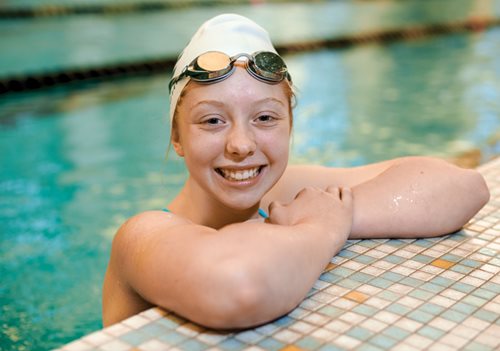 It is sometimes referred to as “dancing in the water,” but synchronized swimming is a precise, rigorous sport that requires discipline, strength and lots of practice. After suffering a serious ankle injury, Isabel Kilty needed the right physical therapy if she was to participate in an upcoming national competition. She found it at Emerson’s Center for Rehabilitative and Sports Therapies.
It is sometimes referred to as “dancing in the water,” but synchronized swimming is a precise, rigorous sport that requires discipline, strength and lots of practice. After suffering a serious ankle injury, Isabel Kilty needed the right physical therapy if she was to participate in an upcoming national competition. She found it at Emerson’s Center for Rehabilitative and Sports Therapies.
The Concord-Carlisle High School student fell during a cheerleading competition last fall. “All my weight went on my left ankle,” Isabel recalls. “It got really swollen.” A trip to the Emerson emergency department confirmed that it was a bad sprain, and Isabel spent a few weeks on crutches.
She then re-sprained her tender ankle and had to immobilize the joint by wearing a boot. Instead of practicing with the swim team, the 15-year-old watched — and wondered if she would be able to join them for the national competition. Her ankle needed to be strong enough to perform the intense eggbeater kick, a way to tread water using only the legs. Her overall conditioning was another concern.
“Synchronized swimming requires endurance — immense cardio-fitness,” notes Jodie Kilty, her mother. “Isabel swims four times a week, and has since she was eight.” The Kiltys soon decided it was time to contact John Cahoy, MD, PhD, Emerson’s pediatric orthopedic surgeon. It was mid-December, and the first swim meet was scheduled for mid-January.
“I could tell Isabel was frustrated,” says Dr. Cahoy. “Our job often includes getting athletes beyond their injury to physical, and mental, recovery. Many of the kids we treat have never injured themselves before, so we talk about what it will take to recover.
“Given the length of time since the injury, I ordered an MRI to take a close look at Isabel’s ankle, which was reassuring,” he adds. “Then it was a matter of selecting a physical therapist who would work well with her.”
A triumphant return to competition
Isabel began regular sessions with Josh Avery, PT, DPT, and made immediate progress. “Josh was strict, which was good,” she says. “He wanted me to do lots of repetitions. It was painful, but I was getting better.” With the goal of returning to the pool and helping her teammates in the upcoming competition, Isabel got up early, before school, to perform the home exercise regimen that Mr. Avery designed for her.
“A patient needs to understand the injury and the recovery, so along with creating a rapport, I emphasize education,” Mr. Avery says. “Isabel and her parents needed to understand what we were doing and why we were doing it. There would be some discomfort, but we had a plan.”
Isabel’s ankle responded to the methodical PT sessions and exercise at home. “It got stronger, and so did my leg muscles,” she says. Three weeks after beginning PT with Mr. Avery, she was swimming again.
“I was impressed, but not surprised, at how her ankle responded,” says Mr. Avery. “She turned the corner and accelerated, thanks to her diligence and commitment.”
Meanwhile, Concord-Carlisle had won against local, regional and northeast teams and were ready to compete against the best in the U.S. Isabel participated, including in the nationals in Lewisville, Texas. “We were relieved and delighted that it was going to happen,” says Ms. Kilty. “We had thought Isabel’s season was over.”
Looking back, she appreciates the care her daughter received at Emerson. “I’m impressed with Dr. Cahoy’s expertise and professionalism. Also, Josh treated Isabel as an adult, which was the right approach.”
There was good news in Texas. “Eighteen U.S. teams competed, and we came in eighth,” Isabel reports, noting that it was a big deal. “Our team had never scored in the finals before.” She helped them get there.

